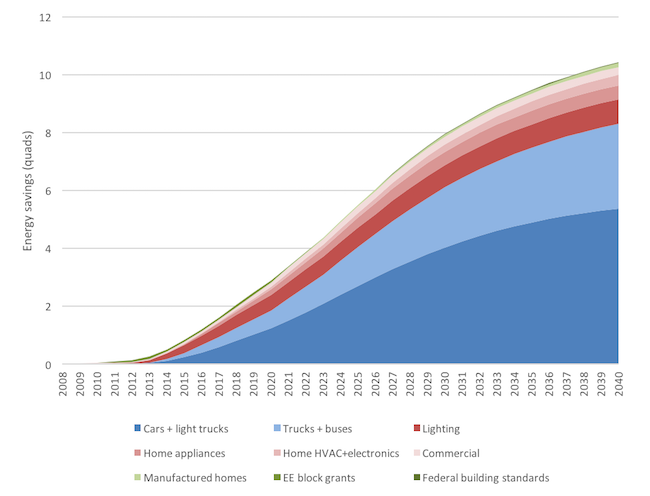Given President Obama’s focus on the climate and green jobs, it may be a surprise that much of what the Obama administration has done on those issues is implementing a bill that Congress passed with bipartisan support and President George W. Bush signed: the Energy Independence and Security Act of 2007 (EISA). And it may be equally surprising that eight years later, parts of that bill still remain on the shelf.
Today, we are releasing a review of the implementation of EISA (one in an occasional series of reports looking back to see whether energy efficiency legislation actually worked). In fact, EISA’s effects have been remarkable. Vehicle fuel economy standards, equipment efficiency standards, major new efficiency programs, and federal energy management have helped change the trajectory of energy use in the United States.
The Projected Long-Term Impact of EISA Energy Efficiency Provisions
- Save consumers over $2 trillion
- Reduce oil use by almost 3 million barrels a day in 2030
- Reduce total energy use by 8 quads (8%) in 2030
- Cut cumulative CO2 emissions by 17 billion metric tons
I’ll note that those savings are 5-20 times the savings we projected in a recent paper for a set of ten provisions currently under consideration by Congress.
Key outcomes from EISA include the following:
Vehicle standards
EISA required the first major boost in vehicle fuel economy standards since they were created three decades earlier. For cars and light trucks, it directed an increase from about 25 miles per gallon to 35 mpg in 2020. But the administration leveraged authority in EISA with federal support for the automakers in crisis, and with pressure from California regulators, to go well beyond the EISA minimum, to 45 mpg in 2025. (Note that on-road mpg figures are about 20% lower than these numbers, which are used for standards.) As directed in EISA, the administration also set the first standards for heavier trucks and buses in 2011, again with broad support, and is working on the second round.
Equipment and lighting standards
Even though political opposition has suspended federal enforcement of it, the light bulb standard continues to promote new technology options, like LEDs, that are saving consumers billions of dollars. The Department of Energy also has ramped up an unprecedented series of other standards and test procedures with major energy savings. We project that standards from EISA will save consumers over $200 billion.
Efficiency programs
The Recovery Act and other stimulus legislation unexpectedly poured billions of dollars into programs authorized by EISA for state and local governments, the auto industry, utilities, and others. Some other programs, however, have yet to save energy because they have not yet been funded.
Housing policies
Although model building energy codes have been updated to achieve large energy savings, long delays have slowed their application, under EISA, to manufactured housing and new homes with federal assistance such as FHA loans.
Thus, a number of actions under EISA remain for the last year of the administration. Some of the most important pending actions (and the responsible agencies) are:
- Heavy-duty vehicle standard update (DOT and EPA)
- Multiple new and updated appliance efficiency standards and test procedures (DOE)
- Manufactured housing efficiency standard (DOE)
- Update to efficiency requirement for federally assisted housing (HUD and USDA)
- Work toward efficiency labels for tires and electronics (DOT and FTC)
Assuming these actions are completed, the figure below shows the growth in energy savings over time that we project from the provisions.
The savings have not come easily. The implementation of the bill has been marked by the Great Recession, the election of President Obama in 2008, and subsequent stimulus legislation and political backlash. It has shown the difficulty of interpreting broad legislation, the pitfalls of political shifts, and the slow pace of agencies’ deliberative processes. But it has also shown that bipartisan legislation, a committed administration, and stakeholder support can make a real difference. This collaboration has saved consumers billions of dollars, reduced our dependence on oil, and improved the environment.
We hope that the Obama administration will complete the rest of the to-do list, and that the current Congress will take up the baton and hand a strong efficiency agenda to the next president.




